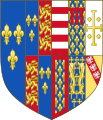Датотека:Arms of Margaret of Anjou.svg
Appearance

Veličina PNG pregleda za ovu SVG datoteku je 408 × 477 piksela. 5 drugih rezolucija: 205 × 240 piksela | 410 × 480 piksela | 657 × 768 piksela | 876 × 1.024 piksela | 1.752 × 2.048 piksela.
Originalna datoteka (SVG datoteka, nominalno 408 × 477 piksela, veličina: 1,41 MB)
Istorija datoteke
Kliknite na datum/vreme da biste videli tadašnju verziju datoteke.
| Datum/vreme | Minijatura | Dimenzije | Korisnik | Komentar | |
|---|---|---|---|---|---|
| trenutna | 07:05, 19. februar 2015. |  | 408 × 477 (1,41 MB) | Sodacan | fix Bar quarter |
| 12:56, 5. avgust 2013. |  | 408 × 477 (1,43 MB) | Sodacan | size | |
| 12:28, 5. avgust 2013. |  | 408 × 465 (1,43 MB) | Sodacan | sizing | |
| 08:47, 16. jul 2013. |  | 436 × 465 (1,45 MB) | Sodacan | User created page with UploadWizard |
Upotreba datoteke
Sledeća stranica koristi ovu datoteku:
Globalna upotreba datoteke
Drugi vikiji koji koriste ovu datoteku:
- Upotreba na af.wikipedia.org
- Upotreba na ar.wikipedia.org
- Upotreba na arz.wikipedia.org
- Upotreba na ast.wikipedia.org
- Upotreba na azb.wikipedia.org
- Upotreba na be.wikipedia.org
- Upotreba na bg.wikipedia.org
- Upotreba na ca.wikipedia.org
- Upotreba na cs.wikipedia.org
- Upotreba na da.wikipedia.org
- Upotreba na de.wikipedia.org
- Upotreba na el.wikipedia.org
- Upotreba na en.wikipedia.org
- Upotreba na eo.wikipedia.org
- Upotreba na es.wikipedia.org
- Upotreba na eu.wikipedia.org
- Upotreba na fa.wikipedia.org
- Upotreba na fr.wikipedia.org
Još globalnog korišćenja ove datoteke.
